Archive for December, 2015
The Gala Dress
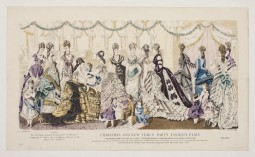
A Gala is a big party where ladies use to wear their fanciest ball gown. The definition of this kind of party and the costume habits are strictly connected, in fact the word “Gala” comes from the old French Gale.
Evening dress is the prevailing style prescribed by fashion to be worn in special occasions, with surprisingly complex expectations related to appropriateness of the outfit. Regardless of the era, it is intricately connected to fashions of the day, with specific characteristics that distinguishes it from everyday dress. The evening gown especially amplifies a woman’s femininity, intensifying her desirability.
Evening wear for women, also known as court dress in the past, has its origins in the 15th century with the rise of the Burgundian court and its fashionable ruler, entitled Philip the Good. Rich fabrics and bright colours were used by the nobility as a signifier of social status. During the 16th and 17th centuries a vibrant court life allowed fashionable ladies to showcase their finery, making Italian Renaissance courts a landmark of style and elegance in Europe. Later in the Baroque era, the focus began to shift to France and the court of Louis XIV.
During the 18th century, a ball or evening dress was synonymous with court dress, as balls took place at court. By the 1820s, fashion had been fairly democratized. Additionally, Parisian and American fashion magazines has gained popularity among women in the United States and Europe. Godey’s Lady’s Book and Peterson’s Magazine used to publish fashion plates with captions of dresses illustrated according to explicit activities or time of day. From these labels, it seems the evening dress was born.
Today, the evening gown comes in different silhouettes and even lengths, but the full-skirted ball gown remains the pinnacle of formality. Limited to formal or semi-formal events, women’s gowns vary drastically from black garments to revealing objets d’art, drawing attention to a woman’s body, establishing her as an object to be gazed upon by her audience.
Take a look to our glamourous selection of Ball Gowns on Europeana Fashion Portal and find an inspiration for your New Year’s Eve look!
“Jacqueline de Ribes: The Art of Style” at The Metropolitan Museum’s Costume Institute
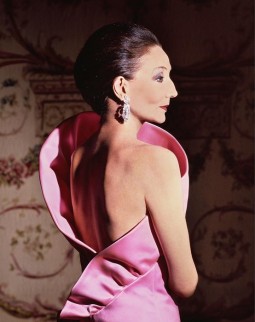
A muse for the greatest couturiers and a fashion designer herself, Jacqueline de Ribes is the protagonist of a monographic exhibition held at the Metropolitan Museum’s Costume Institute until the 21st February 2016.
The Countess Jacqueline De Ribes’ sense of style is legendary. She was the muse and collaborator of Yves Saint Laurent and Valentino, the subject of photographers of the likes of Richard Avedon and even one of the Swans of Truman Capote. She used to customize her couture by cutting her old gowns to create new fancy dress for the balls and she became a fashion designer herself, directing her successful business from 1982 to 1995.

Featuring more than sixty ensembles from the Countess’ personal archive, dating from 1962 to present, the exhibition “Jacqueline de Ribes: The Art of Style” tells the story of de Ribes’ interest in fashion to show how it developed and eventually made her “the epitome of international style”.

The story – told through the beautiful creations by Giorgio Armani, Pierre Balmain, Marc Bohan for House of Dior, Valentino and Emmanuel Ungaro, among others, all worn by the Countess and shown in the exhibition along her own designs – is also documented through a wide range of photographs, videos and ephemera that all recount de Ribes’ haute aesthetic.
For more information about the exhibition, please visit the Metropolitan Museum’s Costume Institute. Browse also Europeana Fashion event section to find more exhibitions and events to attend!
The Gansey Jumper
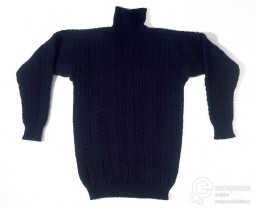
One of the most popular garments to wear in winter, jumpers are also a piece of clothing which had different meanings during the centuries, which differ from place to place and from design to design.
The Gansey, or Guernsey jumper – named after the island of Guernsey, part of the group of the Channel Islands in the English Channel, where it was created – is a woollen fisherman’s jersey, part of the traditional clothing of the island.

Gansey jumper of combed and hand-knitted worsted, made in Staithes, 1980. Collection Victoria and Albert Museum, CC-BY-NC.
This type of navy coloured sweater was favored by fishermen for its characteristic close-fit, which resulted in make them feel warmer, and its tight knit, which repelled water. The one in the picture, designed by Joseph Ettedgui, is part of the Victoria and Albert Museum’s collection and dated 1980. Made in the East Yorkshire fishing village of Staithes, it is worked in the round, without side seams, in a pattern of vertical panels with alternate cable and double moss stitch.
The first Guernsey jumpers were produced in the early 16th century, when the island obtained, by the Crown, the license to import wool from England and export knitted goods. They were originally hand–knitted in one piece and designed to keep the wearer warm and dry in all conditions. In the 19th century they become part of the rating uniform of British Royal Navy and during the 1880s there was a craze for a fashionable female version of the jersey.
In addition to Guernsey jumpers, a consistent part of Europeana Fashion collection is composed of knitwear designs, from folk costumes to designers’ creations! Browse it to find more beautiful records!
Gentleman of Fashion: Oscar de la Renta
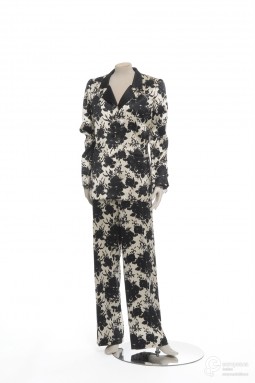
Celebrated this year with two monographic exhibitions, Oscar de la Renta was a world renowned fashion designer, whose life intertwined with the most successful stories of fashion history.

Evening dresses designed by Oscar de la Renta, set at SCAD FASH. The exhibition is open until December 31st. SCAD FASH, all rights reserved.
Oscar de la Renta was born in 1932 in an aristocratic family of Santo Domingo, in the Dominican Republic. He left the city at the age of 18 to move to Madrid, where he studied art at The Academy of San Fernando. It was when one of his gowns – that the wife of the U.S. Ambassador to Spain commissioned him to design for her daughter – appeared on “Life” magazine, that the designer decided to focus himself on fashion.

Oscar de la Renta S/S 2011 collection. Photo by Etienne Tordoir. Collection Catwalkpictures, all rights reserved.
In his first formative years, de la Renta did an apprenticeship at Cristobal Balenciaga, the country’s most succesful couturier at the time. He then travelled to Paris to became assistant designer to Antonio Castillo at Lanvin, until when in 1963, mentored by Diana Vreeland, the then American Vogue editor, De la Renta moved to New York to work for Elizabeth Arden. Two years later, in 1965, he founded his own label.
His designs were influenced by his Dominican and Spanish heritage, and to exotics silhouettes he accustomed a personal use of colours and prints, which provided him an instant success. Among the great personalities he dressed during his long career as a designer, De la Renta is known for dressing every first lady since Jacqueline Kennedy. Also from 1993 to 2002, De la Renta designed the haute couture collections for Balmain, actually becoming the first American designer to be commissioned by a French haute couture house.

Tailleur designed by Oscar de la Renta for Balmain, 2001. Photo by Jean Tholance, all rights reserved.
He died last year, on the 20th October, but he was immediately celebrated by the many institutions which loved his work and recognised him as one of the greatest American designers. Now on view there is an exhibition at SCAD FASH, in Atlanta, and next March will open the exhibition “Oscar de la Renta” at The Museum of Fine art of San Francisco.
Browse Europana Fashion collection to find the beautiful creations by Oscar de la Renta!
Christmas cards to enjoy Christmas time!
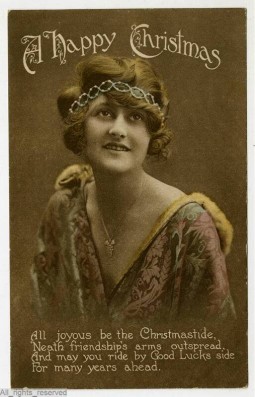
Europeana Fashion presents December’s Tumblr Curation by Rossimoda shoe museum with a huge collection of Christmas Cards.
Since the middle age the habit to send greeting cards to the acquaintances has been quite common. In China people used to write them by hand on rice paper, and the cards were as bigger as great was the person they were addressed. In the Christian world, instead, upper classes people started around 1400 to send greeting cards, writing them by hand, until 1700, when they were replaced by printed cards.
With the invention of litography, in 1976 by the Austrian writer Aloys Senefelder, undreds of cards were introduced on the international market for a huge distribution. In 1840, when the first postage was printed, sending cards for holidays became a custom. The first official greeting card was realized in 1843 by the English painter John Calcott Horsley. At that time just upper classes could buy them, but the lower classes soon developed the way to realize them at home.
In 1860 Louis Prang, a German immigrant, opened a lithography laboratory in Boston, popularizing greeting cards in North America. In 1885 he had the idea to draw Santa Claus with a red dress on cards, finding a great success through the public and making it the official dress of Santa. After the 1950 greeting cards overflowed North America and Europe and people started to use them to celebrate any occasion, as births, birthdays, easter, weddings. Some multinational market as Hallmark quickly understood the profits they can take from a mass trade of greeting cards and built real empire, producing a great variety of new and original cards, for everybody.
Follow Rossimoda Shoe Museum’s December curation on Europeana Fashion Tumblr and enjoy other Postcards from our Archive on Europeana Fashion Portal!
“Oscar de la Renta”: the exhibition at SCAD!
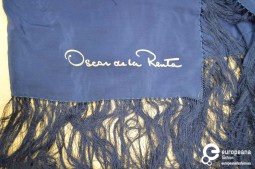
At SCAD FASH in Atlanta, the inaugural exhibition at the Savannah College of Art and Design’s new museum of fashion celebrates the illustrious life and designs of the couturier whose work was said to have set the standard for timeless elegance.
Curated by Laurie Ann Farrell, executive director of SCAD museums, it also introduces the work of Peter Copping, the talented designer personally selected by Oscar de la Renta to lead the iconic brand into the future.
Aiming to highlight the future direction of the fashion house, the exhibition features more than 60 garments, many designed exclusively for de la Renta’s closest friends and family by “the sultan of chic”, de la Renta himself, close to a stunning selection of new looks from Copping’s Fall 2015 show.
Additionally, the exhibition includes “Ovation for Oscar” a SCAD-commissioned short subject documentary that premiered at the Marché du Film at the Cannes Film Festival earlier this year. Directed by SCAD alumni and students, the film provides an intimate account of the making of a major museum exhibition honoring the designer, artist and cultural icon.
Find amazing Oscar de la Renta items on European Fashion Portal and see more information about the exhibition on Europeana Fashion Events area!








